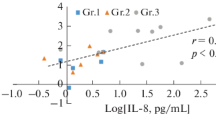Abstract
The mechanism of progression of appendicitis has not been clarified. We esamined tissue superoxide dismutase (SOD) activity, thiobarbituric acid reactive substance (TBARS), and the localization of Cu, Zn-SOD in 56 inflamed appendices in relation to histopathological classification. There was a significant difference in SOD activity between catarrhal appendix and phlegmonous and gangrenous appendix (2.3±0.1 vs 5.0±0.2 and 4.6±0.6 units/mg protein, respectivelyP<0.05). TBARS value was highest in gangrenous appendix, being significantly different from the levels in the other two types (0.47±0.40 vs 0.19±0.01 n mol/mg protein, in catarrhal and 0.20±0.02, in phlegmonous appendixP<0.05). Positive staining for Cu, Zn-SOD was demonstrated in 64% of catarrhal appendices, 96% of phlegmonous appendices, and 75% of gangrenous appendices, and intense positive staining was recognized in 9%, 28%, and 40% of these appendices, respectively. These results indicated that active oxygen influences the degree of inflammation in phlegmonous and gangrenous appendicitis. Gangrenous appendicitis and the other two types of appendicits seemed to be different entities.
Similar content being viewed by others
References
Bohrod MG: The pathogenesis of acute appendicitis. Am J. Clin Pathol 1946:16:752–760
Babekir ARE, Devi N. Analysis of the pathology of 405 appendicites, East Afr Med J 1990;67:599–602.
Chang AR. An analysis of the pathology of 3003 appendices. Aust NZ J Surg 1981;51:169–178.
Andreou P, Blain S, Du Boulay CEH. A histopathological study of the appendix at autopsy and after surgical ewsection. Histopathology 1990;117:427–431.
Suematsu M, Suzuki M, Kitahora T, et al. Increased respiratory burst of leucocytes in inflammatory bowel disease-analysis of free radical generation using a chemiluminescence probe. J Clin Lab Immunol 1987;24:125–128.
Kitahara T, Suzuki K, Asakura H, et al. Active oxygen species generated by monocytes and polymorphonuclear cells in Crohn's disease. Dig Dis Sci 1988;32:951–955.
Segal GH, Petras RE. Verniform appendix. In: Sternberg SS (ed) Histology for pathologists., New York: Raven 1992:593–905.
Morson BC, Dawson IMP, Morson and Dawson's gastrointestinal pathology, Oxford: Blackwell Scientific, 1989.
Asayama K, Uchida N, Dobashi K, et al. Immunohistochemical localization of copper zinc and manganese superoxide dismutase in murine tissues: Comparison with the results in rat. J Act Oxyg Free Red. 1991;2:122–129.
Nakamura S. Appendix In: Iijima S ed Current encyclopedia of pathology 12C. Tokyo: Nakayama Shoten, 1994;121–146.
Yamamoto K, Tasumura T, Appendicitis. In: Wada T (ed) New encyclopedia of Surgical Science 23B Tokyo: Nakayama Shoten, 1990;111–143.
Sonoda M, Asakuno G, Matsuki M et al. Radical trapping PBN during reperfusion in rabbit gastric mucosa. Free Rad Res Comms 1993;19:185–191.
Yagi K. A simple fluoremetric assay for lipid peroxide in blood plasma. Biochem Med 1976;15:212–216.
Mashiko S, Suzuki N, Koga S et al. Measurement of rate constants for quenching singlet oxygen with a cypridian lucife-rin analog (2-methyl-6[P-methoxyphenyl]-3, 7-dihydroimidazo (1.2-a) pyrazin-3-one) and sodium azide. J Biolumin Chemilumin 1991;6:69–72.
Yoshikawa T, Naito Y, Kondo M. The role of free radicals in the pathogenesis of human disease. J Acta Oxyg Free Rad 1990;1:83–102.
Rossi F. The O2-forming NADPH oxidase of the phagocytes: Nature, mechanism of activation and function. Biochem Biophys Acta 1986;853:65–89.
Aschoff L. Die Wurmforstsatzentzündung. Jena: Gustav Fischer, 1908.
Stone HH, Sanders SL, Martin JD. Perforated appendicitis in children. Surgery 1971;69:673–679.
Andersoon, R, Hugander A, Thulin A, et al. Indication or operation in suspected appendicitis and incidence of perforation. BMJ 1994;308:107–110.
Luckman R. Incidence and case fatality rates for acute appendicitis in California. Am J Epidemiol 1989;129:905–918.
Ambjornsson E, Bengmark S. Obstruction of the appendix lumen in relation to pathogenesis of acute appendicitis. Acta Chir Scand 1983;149:789–791.
Author information
Authors and Affiliations
Rights and permissions
About this article
Cite this article
Satomi, A., Hashimoto, T., Murakami, S. et al. Tissue superoxide dismutase (SOD) activity and immunohistochemical staining in acute appendicitis: Correlation with degree of inflammation. J Gastroenterol 31, 639–645 (1996). https://doi.org/10.1007/BF02347610
Received:
Accepted:
Issue Date:
DOI: https://doi.org/10.1007/BF02347610




